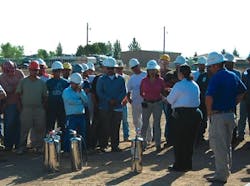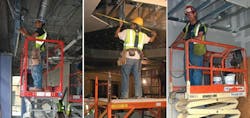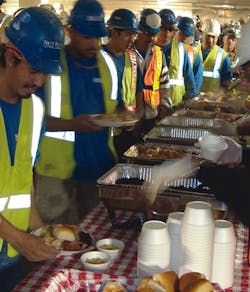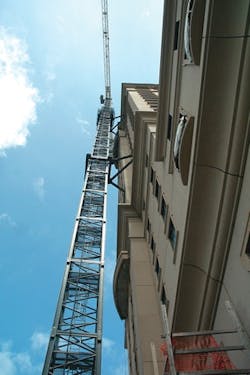3 Construction Companies Share Best Practices in Safety
By Margaret Willard
The end of 2008 represented the completion of a year riddled with construction tragedy. Two people were killed in March when part of a crane fell in Miami; a few months later, a crane collapse in Houston left four construction workers dead and six others injured. New York City saw two grisly accidents in 2008, culminating in a total of nine deaths. And, just this past fall, in Atlanta, a 15-year-old boy fell 40 feet to his death because he wasn't using any safety equipment. An Atlanta bridge collapse at the Atlanta Botanical Garden resulted in one death and more than 12 injuries.
Unfortunately, accidents and injuries are no strangers to the construction industry. According to the most recent data from the U.S. Bureau of Labor Statistics (BLS), construction accounted for 1,178 deaths and more than 371,700 injuries nationwide in 2007, averaging out to more than 1,000 injuries each day and close to 100 deaths every month that year. As a building owner/facility manager, what can you do to make sure that your next construction project doesn't contribute to these statistics?
You'll be relieved to know that, in an effort to transform this history of daunting statistics, several construction companies are leading a new trend of incident intolerance in the construction industry through unwavering commitments to safety programs.
Bovis Lend Lease, New York City, began its mission in 2002 when it adopted a revolutionary safety program: Incident & Injury Free. Within 2 years, Bovis Lend Lease's experience modification rate (EMR), which is calculated by number of incidents and cost of injuries, dropped from 0.46 to 0.34.
Mike Hampton, principal in charge for Bovis Lend Lease's Atlanta office, says he hopes that arduous safety programs will soon become the norm. "I firmly believe that the direction we're headed is leading edge, just like sustainability and green were a few years ago," Hampton says. "Somebody had to champion those causes for a long time before they caught on, and we're trying to do that for construction safety."
Balfour Beatty Construction is committed to safety with its Zero Harm safety program, which has set a companywide goal to achieve zero construction incidents by 2012. "When you deconstruct the accidents and deaths in our industry, every single one could have been avoided," says Balfour Beatty Atlanta President Jeff George. "The No. 1 responsibility we have is to make sure that each person makes it home at the end of the day. That's all that matters, and that's why we need to make a collective effort as a profession to be committed to safety."
An effective safety program provides an extensive network of planning, procedures, training, and culture that can eliminate the risk of harm on a construction project. On-site safety often begins in the design phase, when project managers and safety personnel take a detailed look at all aspects of a construction site to identify potential safety risks that may arise during construction. By planning ahead to use scissor lifts, bakers scaffolds, or podium-style ladders in place of unsteady A-frame ladders, companies easily eliminate the unnecessary risk of dangerous falls. Furthermore, contractors can also modify construction systems and methods to reduce the risk of injury on a construction site.
While building a new 25-story expansion tower for Lenbrook, Atlanta's only accredited continuing-care retirement community, Bovis Lend Lease's Atlanta office unitized curtainwalls for safer installation. "Because curtainwall hangs off of a building, traditionally, a construction worker is suspended, and ties off at the edges of a slab to install the panels by hand," says Jeff Robertson, project manager for Bovis Lend Lease's Lenbrook construction site. "But, by unitizing curtainwall, we gave workers the ability to stand on the slab and not be exposed to a fall. They always had a panel in front of them instead of an open edge."
Many safety programs also provide preconstruction safety training for each employee's specific job on a construction site. Cox Schepp Construction requires extensive training for state and federal regulatory agencies, such as OSHA, as a part of its NI2 - No Incidents No Injuries - safety program. Furthermore, the company's safety division is bilingual to remove language barriers and make sure every person on the jobsite understands the safety program. "Nothing is lost in translation with any of our employees," says Roy Johnson, safety director at Cox Schepp's Charlotte, NC, office. "It's important to us that everyone gets the proper training and understands what's expected of them from the start."
In addition to a 10-hour OSHA training program, Balfour Beatty also requires that safety supervisors develop a "Site Specific Safety Program" for each project prior to construction, where the safety team identifies potential risks and safety issues that can be addressed during the buyout process, and then produces a plan of action tailored to each individual working on the construction site. The plan gives guidelines for each member of the construction team and explains in detail how that employee should eliminate the safety risk in his/her construction area. Safety supervisors at Balfour Beatty then review the site's safety plan with the construction team, and each crewmember signs off, stating that he/she understands - and will follow through with - the guidelines provided.
A key lynchpin in any safety program is the implementation of an effective orientation program that introduces the concept of a safety culture. On the first day at a construction site, Bovis Lend Lease holds a 90-minute safety session for all construction workers, where a safety supervisor talks candidly with employees and subcontractors about the importance of safety. Hampton says orientation is an important way to introduce the safety program not only as a list of requirements, but also as a state of mind that every employee is committed to. "Our focus with Incident & Injury Free isn't always about rules and regulations - it's about choice," says Hampton. "We don't want to make you wear your hard hat. Our goal is for you to want to wear your hard hat for your own sake."
Half of the battle for any safety program involves developing a safety mentality among employees and reversing years of unsafe construction habits. Many construction workers and subcontractors who are given proper safety guidelines and complete safety training still fall victim to construction accidents. George says the problem is with workers' attitudes toward safety. "Everyone knows the rules, but, all too often, someone gets in a hurry and wants to take a shortcut, and that's when they get hurt. Too many people think they're bulletproof or aren't worried because they think it's going to happen to the other guy," he says. "That's why the most important challenge we face is creating a safety culture that everyone is passionate about."
Because mistakes often result from individual mistakes, construction companies are encouraging their workers to approach safety as a team effort. Safety programs like Incident & Injury Free, NI2, and Zero Harm emphasize that each person on a construction site is accountable for the team's safety. "If a worker sees [an] associate [who's] not working safely, it's his/her responsibility to tell that associate to fix the problem," says Hampton. "Therefore, the blame for any safety blunder lies on the entire construction team and not just one individual."
Another way that these safety programs create a team-oriented safety culture is by using incentive programs to reward good safety practices. As part of its NI2 safety program, Cox Schepp Construction rewards exemplary safety practices with a monetary bonus plan; the company issues an immediate bonus to any supervisor who has a zero-citation walkthrough with an OSHA inspector.
This past fall, on Bovis Lend Lease's Lenbrook construction site, the Atlanta office began a peer-based rewards program where subcontractors give raffle tickets to fellow team members who use safe construction practices. At the end of the month, Bovis Lend Lease held a ticket raffle where subcontractors could win prizes ranging from cash to a coveted parking space.
Bovis Lend Lease's Atlanta office also recently catered holiday lunch for an entire construction crew to celebrate completing more than 1 million incident-free manhours while building St. Regis Hotel and Residences - a 634,000-square-foot, mixed-use, high-rise building located in the heart of Atlanta's Buckhead neighborhood. Thomas Replogle, Bovis Lend Lease's project manager for St. Regis Hotel and Residences, says the holiday buffet was a fun way to celebrate an important safety milestone and thank the team for their hard work. "It was a special day for everyone to relax and pat each other on the back for reaching such a wonderful goal," he says. "It's important to us that each person on our site knows how much we appreciate their extra effort to make every day a safe one."
In addition to rewards programs, safety programs also reinforce good practices through regular evaluations. For instance, Cox Schepp holds weekly site visits for a safety supervisor to walk through a construction site and evaluate safety compliance. Similarly, Balfour Beatty holds weekly safety reviews, and Bovis Lend Lease has monthly safety meetings for the construction team to voice complaints, identify successes, and suggest improvements to create the best possible work environment. "The subcontractors seem to appreciate that we take safety seriously and listen to their input so we can make our sites better," says Hampton. "We definitely care about our workers; that's what's most important to us."
Despite the increasing support of construction safety programs in recent years, there's still resistance within the construction industry. Because safer construction equipment and planning typically cost more than traditional methods, some industry professionals are concerned that safety programs are an unnecessary expense. This is an unfortunate misconception, however, since the average construction accident claim takes longer to recover from, and costs roughly double that of any other industry; therefore, because safety programs prevent countless construction incidents, they actually save companies thousands of dollars and improve productivity in the long run.
Nevertheless, many general contractors and construction companies are still uncommitted to safety programs and comply only with OSHA's minimum safety regulations. Even though he's confident that subcontractors are safe while working on his construction sites, Hampton says he worries that dedication to safety by the subcontractor is only as strong as the contractor he/she works for.
"I'm definitely concerned that, if subs go to work for a different contractor who slacks off on safety, they'll forget everything they've learned with us," Hampton says. "General contractors, across the board, have to be united in [the] fight to improve construction safety. Once we're all on the same page, then the subcontractors will have to get it because it's the same. I just don't want people to wait until they see their friend get killed before they understand that this is no joke. That's an awfully steep price to have to pay."
Safety programs are easily accessible to all construction companies and contractors, and are offered by numerous associations, including OSHA, the Associated General Contractors of America, and Associated Builders & Contractors Inc. (ABC).
Bovis Lend Lease, Cox Schepp, and Balfour Beatty are examples of how the use of a stringent safety program, combined with companywide enthusiasm and commitment, can create an ideal workplace on any construction site.
Margaret Willard is an account coordinator at Schroder Public Relations in Atlanta.




